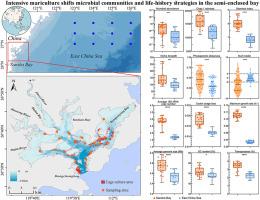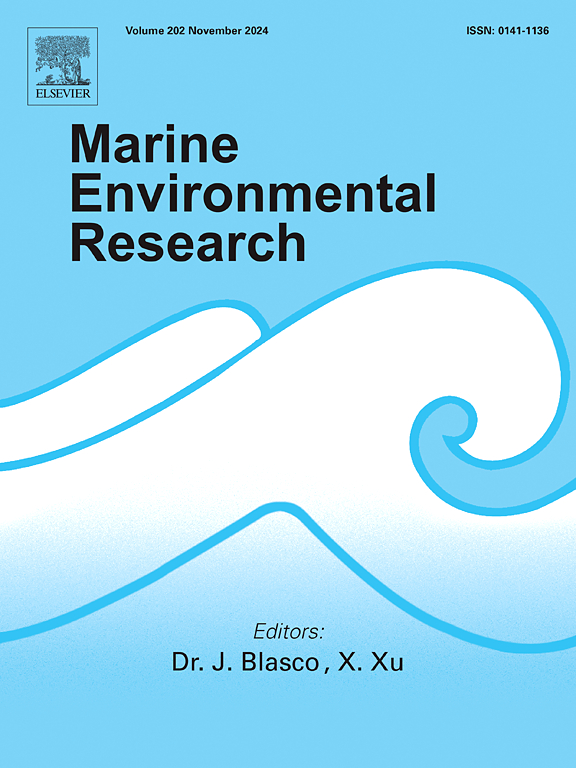Intensive mariculture shifts microbial communities and life-history strategies in the semi-enclosed bay: Case study in Sansha Bay, China
IF 3.2
3区 环境科学与生态学
Q2 ENVIRONMENTAL SCIENCES
引用次数: 0
Abstract
Coastal bays often experience significant disturbances from various mariculture activities, frequently leading to severe eutrophication. Yet, the ecological consequences of nutrient inputs derived from mariculture on bay-associated microbial communities remain insufficiently understood. Sansha Bay, known as the world's largest cage mariculture site for Larimichthys crocea, represents a characteristic semi-enclosed bay commonly utilized for studying the environmental impacts of intensive mariculture. In this study, we compared the highly eutrophic Sansha Bay with the relatively undisturbed natural East China Sea to investigate how intensive mariculture influences the bay microbial biosphere, focusing on community composition, assembly mechanisms, functional profiles, and life-history strategies. Amplicon sequencing and metagenomic analyses showed that Sansha Bay had a greater proportion of fast-growing microorganisms, nitrogen and carbon cycling microbes, and antibiotic-resistant bacteria. Null model analysis indicated that while natural coastal microbial assemblages were predominantly shaped by stochastic processes, deterministic selection became increasingly prominent as mariculture activities intensified. Correspondingly, microbial life-history traits, including 16S rRNA gene copy number, codon usage bias, predicted maximum growth rates, genome size, guanine-cytosine content, transposase abundance, and niche breadth, were consistently elevated in the eutrophic bay. These results suggest that eutrophication associated with mariculture drives a shift in life-history strategies from oligotrophs (K-strategists) to copiotrophs (r-strategists). Collectively, this study yields novel mechanistic understanding of how intensive mariculture reshapes microbial community structures, laying the groundwork for forecasting changes in coastal ecosystems subjected to ongoing human disturbances.

集约化海水养殖改变了半封闭海湾的微生物群落和生活史策略:中国三沙湾的案例研究
沿海海湾经常受到各种海水养殖活动的严重干扰,经常导致严重的富营养化。然而,来自海水养殖的营养投入对海湾相关微生物群落的生态后果仍然没有得到充分的了解。三沙湾是世界上最大的网箱海水养殖场,是一个典型的半封闭式海湾,通常用于研究集约化海水养殖对环境的影响。本研究以高度富营养化的三沙湾与相对未受干扰的东海为研究对象,从群落组成、组合机制、功能特征和生活史策略等方面探讨了集约化海水养殖对海湾微生物生物圈的影响。扩增子测序和宏基因组分析表明,三沙湾的快速生长微生物、氮和碳循环微生物以及耐药细菌的比例更高。零模型分析表明,虽然自然海岸微生物组合主要由随机过程形成,但随着海水养殖活动的加剧,确定性选择变得越来越突出。相应地,微生物生活史特征,包括16S rRNA基因拷贝数、密码子使用偏差、预测最大生长率、基因组大小、鸟嘌呤-胞嘧啶含量、转座酶丰度和生态位宽度,在富营养化海湾中持续升高。这些结果表明,与海水养殖相关的富营养化推动了生活史策略的转变,从少营养型(k -战略型)到共营养型(r-战略型)。总的来说,这项研究对集约化海水养殖如何重塑微生物群落结构产生了新的机制理解,为预测受到持续人类干扰的沿海生态系统的变化奠定了基础。
本文章由计算机程序翻译,如有差异,请以英文原文为准。
求助全文
约1分钟内获得全文
求助全文
来源期刊

Marine environmental research
环境科学-毒理学
CiteScore
5.90
自引率
3.00%
发文量
217
审稿时长
46 days
期刊介绍:
Marine Environmental Research publishes original research papers on chemical, physical, and biological interactions in the oceans and coastal waters. The journal serves as a forum for new information on biology, chemistry, and toxicology and syntheses that advance understanding of marine environmental processes.
Submission of multidisciplinary studies is encouraged. Studies that utilize experimental approaches to clarify the roles of anthropogenic and natural causes of changes in marine ecosystems are especially welcome, as are those studies that represent new developments of a theoretical or conceptual aspect of marine science. All papers published in this journal are reviewed by qualified peers prior to acceptance and publication. Examples of topics considered to be appropriate for the journal include, but are not limited to, the following:
– The extent, persistence, and consequences of change and the recovery from such change in natural marine systems
– The biochemical, physiological, and ecological consequences of contaminants to marine organisms and ecosystems
– The biogeochemistry of naturally occurring and anthropogenic substances
– Models that describe and predict the above processes
– Monitoring studies, to the extent that their results provide new information on functional processes
– Methodological papers describing improved quantitative techniques for the marine sciences.
 求助内容:
求助内容: 应助结果提醒方式:
应助结果提醒方式:


